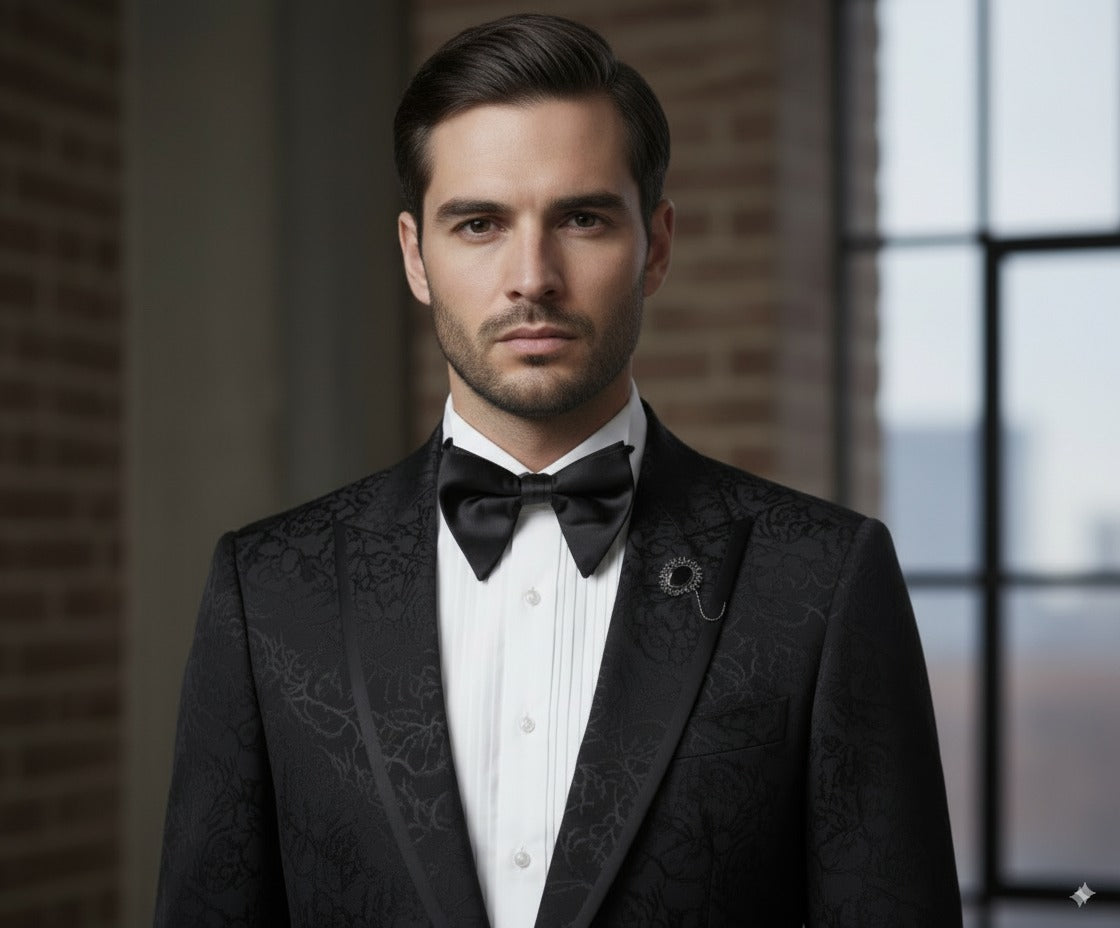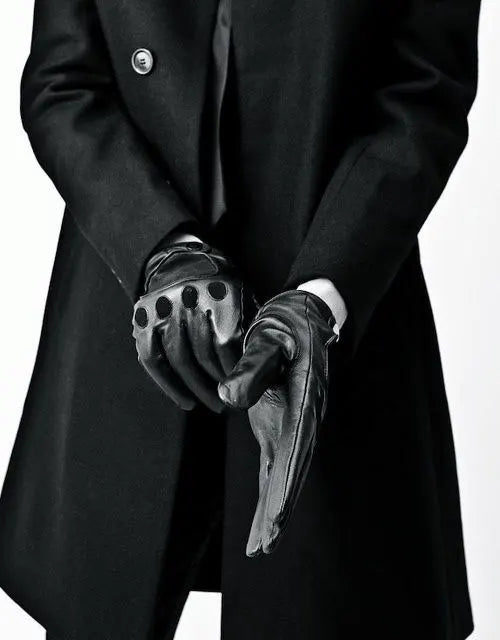
The Complete Guide to Overcoats: Part 3 – Heritage Classics & Outdoor Excellence
Share
Welcome to the final installment of our comprehensive overcoat series! In Parts 1 and 2, we explored nine iconic overcoat styles from the double-breasted overcoat to the military officer's coat. Today, we're concluding with three distinctive styles that combine rugged practicality with timeless appeal: the Ulster coat, the Loden coat, and the Duffle coat. Each represents a unique chapter in outerwear history and offers specific benefits for modern wearers seeking both function and heritage style.
The Ulster Coat: Victorian Drama & Architectural Tailoring
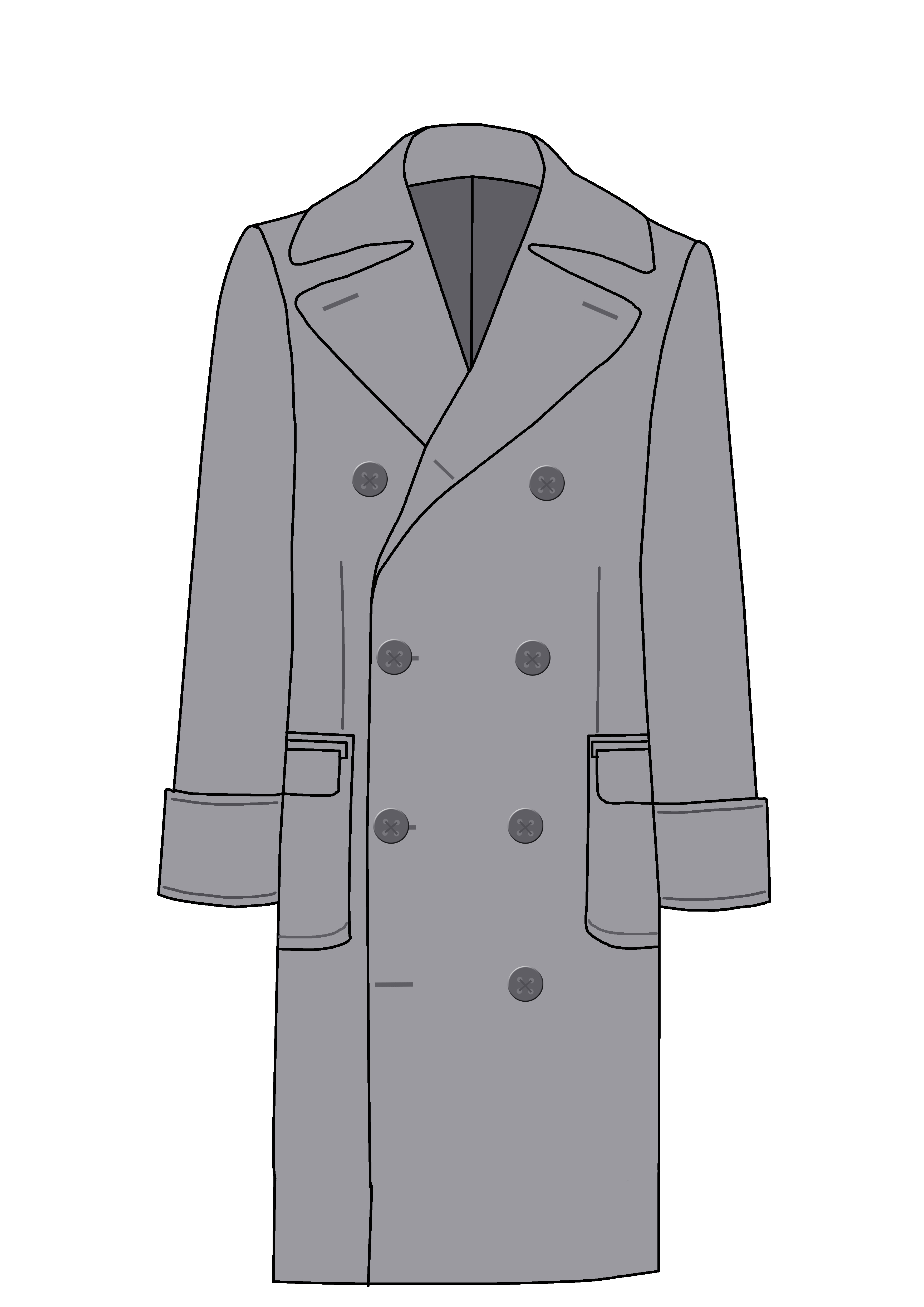
The Ulster coat stands as one of the most architecturally dramatic overcoat styles ever created. Born in Northern Ireland during the Victorian era (1860s-1870s), this coat was originally designed for rugged travel across the Irish countryside. Its most distinctive feature—the detachable cape or shoulder overlay—provided additional protection from rain and wind while creating a commanding silhouette that remains striking today.
Historical Context:
Named after the Ulster province of Northern Ireland, this coat was popularized by Victorian gentlemen who needed robust outerwear for travel by train and carriage. The cape element served a practical purpose: protecting the shoulders and upper arms from rain while allowing freedom of movement underneath. Sherlock Holmes famously wore an Ulster-style coat (often confused with the Inverness cape coat), cementing its place in popular culture.
Tailoring Specifications:
Construction Details:
- Closure: Double-breasted front with 6-8 buttons (6x2 or 8x2 configuration shown)
- Cape/Overlay: Detachable or fixed shoulder cape extending to mid-chest or waist
- Lapels: Wide peaked or notched lapels (3.5-4 inches) beneath the cape
-
Length:
- Men's: Long—falling to mid-calf or just below knee (44-50 inches)
- Women's: Knee-length to midi (40-46 inches) for proportion and practicality
- Sleeves: Full-length sleeves beneath cape; cape has armhole slits for arm movement
- Cuffs: Deep cuffs (3-4 inches) often with button detail or turnback styling
- Pockets: Large patch or flap pockets positioned below cape line
- Belt: Optional half-belt or full belt at back for waist definition
Signature Design Elements:
The Cape/Shoulder Overlay: The Ulster's defining architectural feature requires specialized construction:
- Length: Typically extends to mid-chest (short cape) or waist level (long cape)
- Attachment: Can be permanently attached or detachable via buttons
- Armhole Slits: Vertical openings allow arms to pass through while cape drapes over shoulders
- Construction: Separate pattern piece drafted to drape over coat body
- Lining: Usually unlined or half-lined to reduce bulk
- Function: Provides double-layer protection across shoulders and upper back
Deep Cuff Detail:
- Width: 3-4 inches of turned-back fabric at sleeve end
- Styling: Can be worn turned up (showing lining) or down
- Buttons: Decorative buttons on cuff exterior
- Function: Originally allowed cuffs to be turned down in severe weather
Pattern Considerations:
For Men:
- Shoulder construction: Must accommodate both coat shoulder and cape overlay
- Chest measurement: Extremely generous ease (6-8 inches) for heavy layering
- Length proportion: Requires height of 5'10" or taller to carry full-length style
- Cape drape: Pattern must allow cape to fall smoothly without pulling
- Armhole placement: Cape armhole slits must align with natural arm position
- Back width: Ample across shoulders for both coat and cape layers
For Women:
- Shoulder scale: Cape proportioned for typically narrower shoulders
- Bust accommodation: Coat body fitted beneath cape overlay
- Waist definition: Optional belt emphasizes feminine silhouette
- Length adaptation: Shorter lengths (knee to midi) prevent overwhelming smaller frames
- Cape proportion: Scaled to complement feminine proportions
- Sleeve pitch: Adjusted for typically narrower shoulders and shorter arms
- Hip curve: Gradual A-line from waist prevents pulling
Fabric Selection:
Traditional Choices: The Ulster demands substantial, weather-resistant fabrics:
- Weight: 20-28 oz for maximum protection and drape
- Composition: 100% wool tweed, heavyweight cheviot, or wool-cashmere blends
- Weave: Tweed, herringbone, or plain weave with substantial texture
- Color: Grey (shown), charcoal, navy, brown herringbone, or traditional tweeds
- Characteristics: Wind-resistant, water-repellent, durable
- Recommended Mills: Harris Tweed, Shetland wool, or Irish tweeds for authenticity
Fabric Characteristics:
- Drape: Must be substantial enough to support cape structure
- Weight: Heavy enough for warmth but not so heavy as to restrict movement
- Texture: Traditional tweeds provide authentic Victorian aesthetic
- Durability: Must withstand outdoor wear and frequent use
Hand-Tailoring Elements:
The Ulster's complex construction requires exceptional skill:
- Cape Attachment: Hand-sewn to coat body with reinforced stitching at stress points (100+ stitches)
- Armhole Slits: Hand-bound edges prevent fraying and provide clean finish
- Full Canvas: Heavy canvas throughout coat body for structure
- Lapel Construction: Hand-padded beneath cape for proper roll
- Cuff Turnback: Hand-stitched with decorative buttons
- Pocket Reinforcement: Double-stitched corners for durability
- Lining: Full or half-lined depending on weight; hand-felled seams
- Button Placement: Precisely positioned for proper cape and coat closure
- Hem Weight: Lead weights or chain weight in hem for proper drape
Styling Guidelines:
For Men:
- Country Gentleman: Perfect with tweed suits, country boots, and flat caps
- Urban Drama: Statement piece over business attire for commanding presence
- Travel Wear: Ideal for train, plane, or car travel in cold weather
- Proportions: Best suited to taller men (5'10"+) who can carry the length
- Accessories: Pair with leather gloves, wool scarves, and traditional hats
- Footwear: Requires substantial footwear—country boots or heavy brogues
For Women:
- Heritage Style: Embrace Victorian aesthetic with full-length styling
- Modern Adaptation: Shorter lengths (knee) for contemporary wearability
- Dramatic Evenings: Stunning over dresses for opera or theater
- Country Pursuits: Authentic for rural activities and outdoor events
- Belted Styling: Add belt for defined waist and feminine silhouette
- Accessories: Balance dramatic cape with refined accessories or embrace full heritage look
The Loden Coat: Alpine Heritage & Boiled Wool Excellence
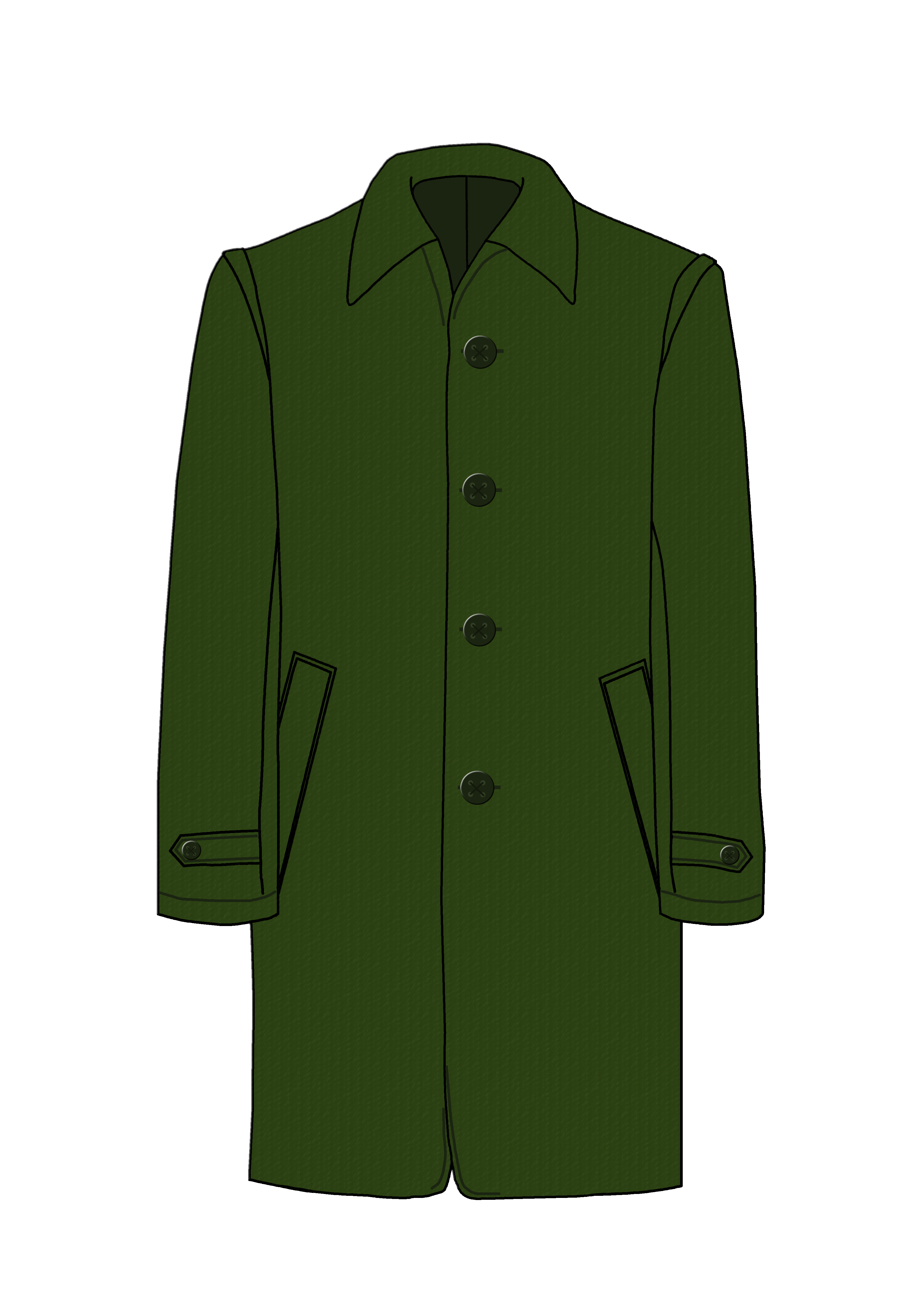
The Loden coat represents centuries of Alpine tradition and one of the most remarkable fabrics ever developed for outerwear. Originating in Austria and Bavaria, this coat showcases Loden cloth—a unique boiled wool fabric that has protected mountain dwellers from harsh weather since the 16th century. Its distinctive forest green color and practical design make it instantly recognizable and eternally stylish.
Historical Context:
Loden cloth was originally created by Alpine farmers and hunters who needed durable, weather-resistant clothing for mountain life. The fabric's name comes from the Old High German word "lodo," meaning "thick cloth." By the 19th century, Loden coats had become fashionable among the Austrian aristocracy for hunting and country pursuits, eventually spreading throughout Europe as the ultimate outdoor coat.
The Loden Fabric: A Technical Marvel
Before discussing the coat's construction, it's essential to understand what makes Loden fabric unique:
Manufacturing Process:
- Raw Wool: Coarse mountain sheep wool is spun into yarn
- Weaving: Woven into loose, open fabric
- Boiling/Fulling: Fabric is boiled and agitated, causing fibers to felt and shrink by 30-40%
- Brushing: Surface is brushed to raise a soft nap
- Finishing: Fabric is steamed and pressed to final specifications
Unique Properties:
- Water Resistance: Felted structure repels water naturally without chemical treatment
- Windproof: Dense, felted weave blocks wind completely
- Breathable: Despite density, allows moisture vapor to escape
- Self-Cleaning: Dirt brushes off easily from smooth surface
- Odor Resistant: Lanolin in wool naturally resists bacteria
- Durable: Can last 20-30+ years with proper care
- Silent: Makes no rustling sound—ideal for hunting
- Weight: 16-24 oz depending on quality grade
Tailoring Specifications:
Construction Details:
- Closure: Single-breasted with 4-5 buttons (typically horn or wood buttons)
- Collar: Wide spread collar or convertible collar (can be worn open or closed)
- Lapels: Notched lapels, 3-3.5 inches wide
- Silhouette: Straight, relaxed fit with minimal waist suppression
-
Length:
- Men's: Falls just above knee (38-42 inches)
- Women's: Knee-length or slightly shorter (36-40 inches)
- Pockets: Angled slash pockets with button-through flaps or patch pockets
- Cuffs: Adjustable cuff tabs with button closure (shown)
- Back: Typically no vent; some styles feature action back or inverted pleat
Signature Tyrolean Elements:
Traditional Details:
- Horn Buttons: Genuine stag horn buttons (traditional) or wood buttons
- Adjustable Cuffs: Button tabs allow tightening against weather
- Reinforced Elbows: Leather or suede elbow patches (optional)
- Game Pocket: Interior pocket for hunting (traditional styles)
- Throat Latch: Hidden button at collar for additional closure
- Corduroy Trim: Some styles feature corduroy collar or cuff trim
Color Tradition:
- Loden Green: The iconic forest/moss green (shown)—most traditional
- Anthracite Grey: Dark charcoal for urban wear
- Navy Blue: Modern alternative
- Camel/Tan: Lighter option for milder climates
- Brown: Traditional hunting color
Pattern Considerations:
For Men:
- Shoulder line: Natural, unpadded shoulder for outdoor mobility
- Chest ease: Generous (5-7 inches) for layering heavy knitwear
- Armhole: Lower, larger armhole for freedom of movement
- Waist suppression: Minimal (2-4 inches) for straight, utilitarian silhouette
- Sleeve construction: Set-in sleeves with ease for active wear
- Back width: Ample for outdoor activities and layering
For Women:
- Shoulder construction: Natural shoulder line maintaining Alpine aesthetic
- Bust accommodation: Subtle darts or princess seaming
- Waist definition: Options from straight (traditional) to gently shaped
- Hip curve: Slight A-line for feminine proportion
- Sleeve proportion: Adjusted for typically narrower shoulders
- Length considerations: Shorter lengths work better for petite frames
- Optional belt: Self-fabric or leather belt for waist emphasis
Hand-Tailoring Elements:
Working with Loden cloth requires specialized techniques:
- Cutting: Sharp shears required; fabric doesn't fray due to felted structure
- Seam Construction: Flat-felled or bound seams for durability and weather resistance
- Button Attachment: Reinforced with backing buttons due to fabric density
- Pocket Construction: Hand-welted with reinforced corners
- Lining: Traditionally half-lined or unlined; modern versions may be fully lined
- Edge Finishing: Raw edges acceptable due to non-fraying nature; often bound for refinement
- Collar Attachment: Hand-sewn with felt undercollar
- Cuff Tabs: Hand-stitched with functional buttons
Styling Guidelines:
For Men:
- Country Pursuits: Perfect for hunting, hiking, and outdoor activities
- Smart Casual: Pair with corduroy trousers, knitwear, and country boots
- Alpine Style: Embrace full Tyrolean aesthetic with traditional accessories
- Urban Adaptation: Works surprisingly well in city settings with tailored trousers
- Accessories: Tyrolean hat, leather gloves, wool scarves
- Footwear: Country boots, hiking boots, or heavy brogues
For Women:
- Outdoor Elegance: Ideal for country walks, rural events, and outdoor activities
- Heritage Fashion: Embrace Alpine tradition with full Loden styling
- Modern Casual: Pair with jeans, boots, and knitwear for contemporary look
- Practical Luxury: Combines functionality with refined European aesthetic
- Accessories: Wool scarves, leather gloves, felt hats
- Footwear: Country boots, ankle boots, or sturdy walking shoes
The Duffle Coat: Naval Heritage Meets Casual Cool
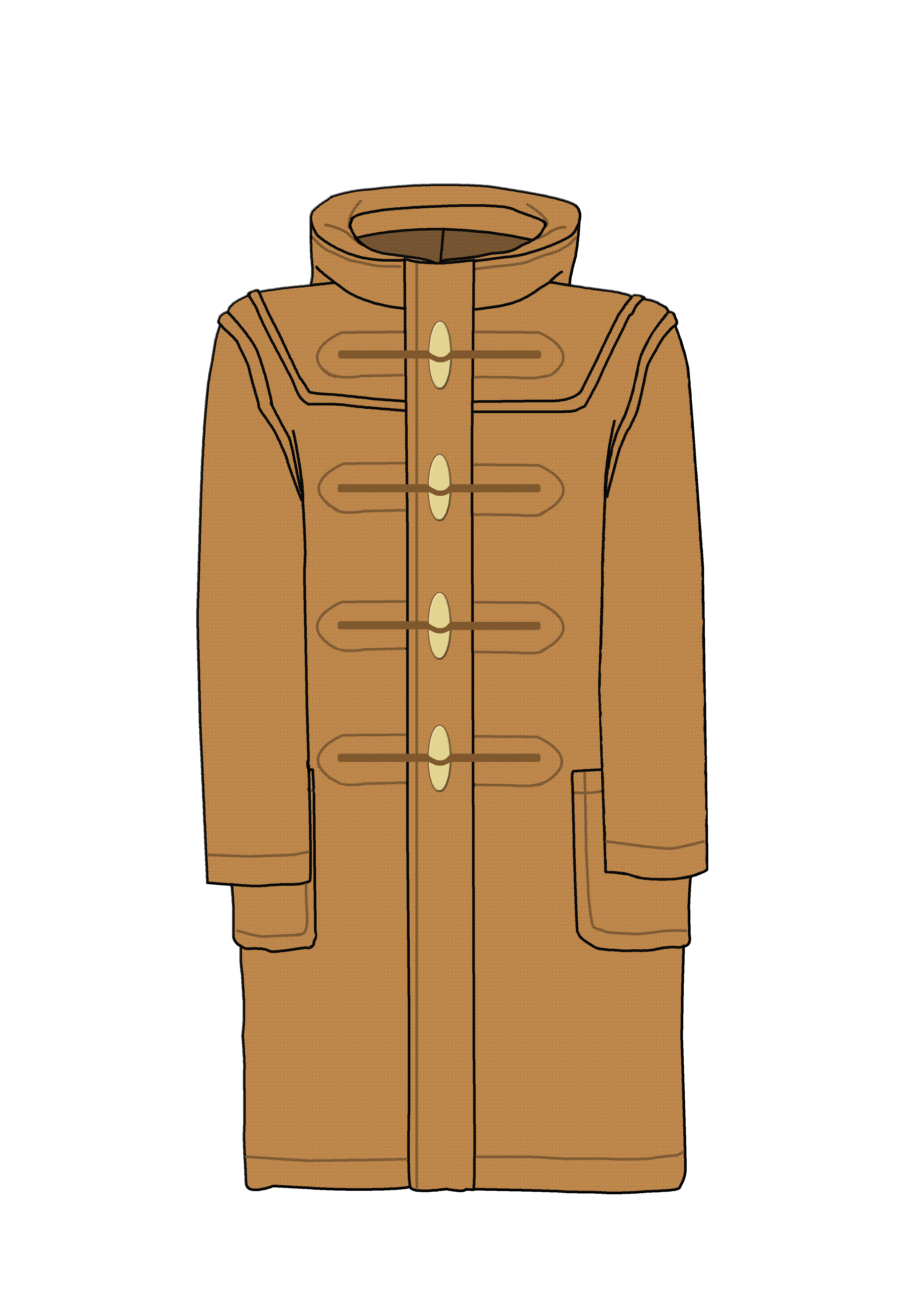
The Duffle coat (also spelled Duffel) represents one of the most successful transitions from military necessity to civilian fashion icon. With its distinctive toggle closures, attached hood, and robust construction, this coat has evolved from Royal Navy standard issue to beloved casual classic worn by everyone from students to style icons.
Historical Context:
The coat's name derives from Duffel, a town in Belgium known for producing the thick woolen cloth used in its construction. While similar hooded coats existed earlier, the modern Duffle coat was adopted by the British Royal Navy in the 1890s and became standard issue during World War II. Field Marshal Bernard Montgomery famously wore his Duffle coat throughout the North African campaign, earning the style its alternative name: the "Montgomery coat."
After WWII, surplus Duffle coats flooded the civilian market, becoming popular with students and bohemians in the 1950s-60s. The style has remained a casual wardrobe staple ever since, transcending age, gender, and fashion trends.
Tailoring Specifications:
Construction Details:
- Closure: Four wooden toggle fasteners with rope or leather loops
- Hood: Attached, generously sized hood (can accommodate hats underneath)
- Collar: No traditional collar; hood attaches directly to neckline
- Silhouette: Boxy, relaxed fit with no waist suppression
-
Length:
- Men's: Hip to mid-thigh length (32-38 inches)
- Women's: Hip to upper thigh length (30-36 inches)
- Pockets: Large patch pockets with top flaps
- Back: No vent; designed for warmth and weather protection
- Yoke: Shoulder yoke for additional weather protection (some styles)
Signature Design Elements:
Toggle Closures: The Duffle coat's most iconic feature:
- Toggles: Wooden (traditionally buffalo horn) barrel-shaped fasteners
- Loops: Rope (traditional) or leather loops sewn to coat front
- Quantity: Typically 4 toggles (some styles have 3 or 5)
- Function: Easy to fasten with gloved hands or frozen fingers
- Durability: Extremely robust; rarely break or fail
- Aesthetic: Instantly recognizable and charmingly utilitarian
The Hood:
- Size: Generously proportioned to fit over naval caps or winter hats
- Attachment: Sewn directly to neckline; no separate collar
- Lining: Quilted or fleece-lined for warmth
- Drawstring: Some styles feature adjustable drawstring for fit
- Function: Complete head and neck protection in severe weather
- Styling: Can be worn up or down; creates casual, approachable aesthetic
- Size: Large, deep pockets for hand-warming and storage
- Construction: Patch-style sewn onto coat exterior
- Flaps: Top flaps protect pocket contents from weather
- Reinforcement: Double-stitched for durability
- Function: Practical storage for gloves, hats, and essentials
- Shoulder line: Natural, unstructured shoulder for casual comfort
- Chest measurement: Very generous ease (6-8 inches) for heavy layering
- Silhouette: Straight, boxy cut with no waist definition
- Armhole: Large, low armhole for freedom of movement
- Sleeve construction: Set-in sleeves with ample ease
- Length proportion: Shorter than formal overcoats for casual versatility
- Hood scaling: Sized to accommodate head with hat underneath
- Shoulder construction: Unstructured, maintaining casual aesthetic
- Bust accommodation: Boxy fit requires no darts; size for comfort
- Waist styling: Traditional straight fit or optional belt for shape
- Hip proportion: Straight through body for authentic naval styling
- Sleeve proportion: Adjusted for typically narrower shoulders and shorter arms
- Length options: Shorter lengths (hip to upper thigh) for feminine proportion
- Hood scaling: Proportioned for typically smaller head size
- Fit philosophy: Embrace relaxed fit or size down for more fitted look
- Weight: 24-32 oz—the heaviest coating fabric
- Composition: 100% wool with heavily fulled, felted finish
- Weave: Plain weave, heavily milled to create dense surface
- Characteristics: Extremely warm, windproof, water-resistant
- Texture: Thick, fuzzy surface with substantial hand
- Color: Camel (shown—most traditional), navy, charcoal, or olive
- Melton Wool: 24-28 oz, similar properties to traditional duffel
- Wool-Nylon Blends: 20-24 oz with enhanced durability
- Technical Fabrics: Modern performance fabrics maintaining traditional aesthetic
- Recommended Mills: British or Italian mills specializing in heavy coating fabrics
- Hood Construction: Pattern drafted for proper drape and coverage; hand-attached to body
- Toggle Loop Attachment: Hand-sewn with reinforced stitching at stress points
- Patch Pocket Application: Hand-stitched to body with reinforced corners
- Seam Construction: Flat-felled or double-stitched for durability and weather resistance
- Edge Finishing: Bound edges or turned-and-stitched hems
- Lining: Full or partial lining hand-felled to body
- Toggle Selection: Genuine wood or horn toggles hand-finished
- Yoke Attachment: Hand-sewn for weather protection (if included)
- Casual Weekend: Perfect with jeans, knitwear, and boots
- Student Classic: Timeless choice for campus and casual settings
- Urban Commuting: Practical for city life and public transportation
- Outdoor Activities: Suitable for casual outdoor pursuits
- Layering: Wear over everything from t-shirts to heavy sweaters
- Accessories: Wool scarves, knit hats, casual gloves
- Footwear: Boots, sneakers, or casual shoes—extremely versatile
- Effortless Casual: Pair with jeans, sweaters, and ankle boots
- Preppy Chic: Classic with button-downs, chinos, and loafers
- Bohemian Style: Works with flowing dresses and tall boots
- Urban Practical: Perfect for city life and everyday wear
- Relaxed Elegance: Dress up with tailored trousers and heels
- Accessories: Chunky scarves, knit beanies, leather gloves
- Footwear: Boots of any height, sneakers, or flat shoes
Choosing Your Perfect Heritage Overcoat
- You want the most dramatic, architecturally striking overcoat
- You appreciate Victorian heritage and historical authenticity
- You need maximum weather protection with distinctive style
- You have the height and presence to carry a statement piece
- You attend formal country events or heritage occasions
- You want a conversation-starting coat with rich history
- You prioritize outdoor activities and country pursuits
- You appreciate Alpine heritage and Central European craftsmanship
- You need genuinely weatherproof, technical performance
- You value sustainability and long-lasting quality
- You prefer understated, functional elegance
- You want a coat that improves with age and develops character
- You need casual, everyday outerwear with naval heritage
- You value practical functionality over formal presentation
- You want versatile styling from casual to smart-casual
- You appreciate iconic, recognizable design
- You need easy-to-use closures and practical features
- You want a timeless piece that transcends fashion trends
Styling Considerations
For Men:
- Wear over suits for Victorian-inspired formality
- Pair with tweed suits and country attire for authentic heritage styling
- Ensure coat length balances with trouser break
- Requires substantial footwear—country boots or heavy brogues
- Best worn with traditional accessories—leather gloves, wool scarves, hats
- Layer over heavy knitwear for outdoor activities
- Pair with corduroy or moleskin trousers for country gentleman aesthetic
- Works surprisingly well in urban settings with dark jeans
- Embrace Tyrolean accessories or keep styling minimal and modern
- Perfect with hiking boots, country boots, or substantial brogues
- Extremely versatile—wear with jeans, chinos, or casual trousers
- Hood eliminates need for hats (but works with beanies underneath)
- Keep styling casual—this isn't a formal coat
- Perfect for layering over everything from t-shirts to thick sweaters
- Pair with boots, sneakers, or any casual footwear
For Women:
- Stunning over dresses for dramatic evening elegance
- Belt at waist for defined feminine silhouette
- Shorter lengths (knee) more practical for everyday wear
- Balance dramatic cape with refined accessories
- Requires heels or substantial boots for proper proportion
- Perfect for country walks and outdoor activities
- Pair with jeans and knitwear for effortless weekend style
- Works beautifully with midi skirts and boots
- Embrace Alpine aesthetic or style with modern minimalism
- Versatile with both flat boots and heels
- Ultimate casual coat—pair with anything in your wardrobe
- Relaxed fit works with fitted clothing underneath
- Hood adds youthful, approachable element
- Can be dressed up with tailored trousers and heels
- Perfect with jeans, dresses, skirts—completely versatile
Fabric & Color Selection Guide
Climate Considerations:
- Ulster Coat: 18-22 oz tweed or wool
- Loden Coat: 16-20 oz Loden cloth
- Duffle Coat: 24-28 oz duffel cloth (naturally insulating)
- Ulster Coat: 24-28 oz heavy tweed or wool
- Loden Coat: 20-24 oz heavyweight Loden
- Duffle Coat: 28-32 oz heavyweight duffel with full lining
Color Versatility:
- Ulster: Charcoal grey, navy, or brown herringbone
- Loden: Traditional loden green (surprisingly versatile)
- Duffle: Camel (classic), navy (versatile), charcoal (modern)
- Ulster: Traditional tweeds—herringbone, check, or plain
- Loden: Forest/moss green (iconic and traditional)
- Duffle: Camel (original Royal Navy color)
- Ulster: Solid charcoal or navy for urban wear
- Loden: Anthracite grey or navy for city styling
- Duffle: Navy or charcoal for contemporary aesthetic
Investment & Care Considerations
- Ulster Coat: 20-30+ years with proper care and occasional repairs
- Loden Coat: 30-40+ years; improves with age and develops patina
- Duffle Coat: 15-25+ years; extremely durable construction
- Professional dry cleaning only
- Store on wide, shaped hangers
- Brush regularly to remove dirt and maintain fabric
- Moth protection essential for wool tweeds
- Cape may require separate pressing
- Minimal cleaning required—brush dirt off when dry
- Professional cleaning only when absolutely necessary (once every 2-3 years)
- Hang to air after wearing in rain
- Loden is naturally self-cleaning and odor-resistant
- Store flat or on wide hangers
- Brush regularly to maintain fabric surface
- Professional cleaning when needed
- Check toggle attachments annually
- Replace worn rope loops as needed
- Store on sturdy hangers to maintain shape
- One well-made heritage coat vs. multiple fast-fashion replacements
- Traditional fabrics from sustainable sources
- Timeless designs never go out of style
- Can be repaired, refreshed, and passed down through generations
- Supports traditional craftsmanship and artisan skills
The A Hand Tailored Suit Difference
Special Considerations for Heritage Styles
- Each style fills a distinct functional and aesthetic niche
- Historical authenticity adds depth to personal style
- Conversation pieces that tell stories and spark connections
- Investment pieces that appreciate in sentimental value
- Start with the most versatile style for your lifestyle (Duffle for casual, Chesterfield for formal)
- Invest in authentic fabrics—they justify the bespoke investment
- Trust the process—heritage styles require specialized expertise
- Plan for the long term—these coats should last decades
- Heritage styles offer new challenges and rewards
- Consider completing a "collection" of classic styles
- Experiment with authentic regional fabrics (Alpine Loden, Irish tweed)
- Explore historical accuracy vs. modern adaptation
The Complete Overcoat Wardrobe
- Formal: Chesterfield (black or charcoal) for evening and business formal
- Versatile: Trench Coat (beige or navy) for all-weather, multi-occasion wear
- Casual: Duffle Coat (camel or navy) for everyday and weekend wear
Completing Your Overcoat Education
- Double-Breasted Overcoat
- Single-Breasted Topcoat
- Pea Coat
- Trench Coat
- Chesterfield Coat
- Military Officer's Coat
- Ulster Coat
- Loden Coat
- Duffle Coat
Ready to Create Your Bespoke Heritage Overcoat?
- Which heritage style best suits your lifestyle and wardrobe
- Authentic fabric selection from traditional sources
- Customization options while maintaining historical integrity
- Fit considerations for your unique proportions
- Timeline and investment for your bespoke heritage overcoat
- Care and maintenance for decades of wear
- Perfect Fit: Pattern created specifically for your body
- Authentic Construction: Traditional techniques rarely found in modern manufacturing
- Fabric Quality: Access to premium, authentic materials
- Customization: Every detail tailored to your preferences
- Longevity: Superior construction ensures decades of wear
- Heritage Preservation: Supporting traditional craftsmanship
- Website: ahandtailoredsuit.com
- AI-Powered Measurement App: Download for contactless precision fitting
- Showroom Appointments: Available for in-person consultations and fabric selection
- Virtual Consultations: Connect with our master tailors from anywhere
"PEOPLE WILL STARE. MAKE IT WORTH THEIR WHILE" - HARRY WINSTON -
A Hand Tailored Suit, the bespoke tailoring company offering you a slice of London’s Savile Row, for a cut of the cost.
If you have a special event or wedding to attend, an autumn gathering, or a cozy office fall celebration, we can create a unique bespoke ensemble just for you. From hand-crafted wool and tweed jackets to custom shirts, corduroy pieces, and merino wool tailored trousers perfect for the season’s crisp air.
Get in touch with our talented tailoring team today.
You can either design online or book in with one of our talented tailoring team. All garments are hand-made to fit your unique body pattern & size.
